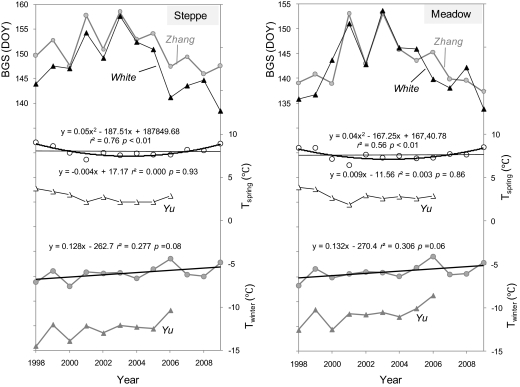Yu et al. (1) reported that the beginning of vegetation growing season (BGS) of the alpine steppe and meadow on the Tibetan Plateau was delayed since the mid-1990s under warming winter and spring (1). They wrote that “this delay appeared to be related to later fulfillment of chilling requirements,” and they suggested that “continued warming may strengthen this effect or even reverse the advancing trend in spring phenology” (1).
This idea was proposed earlier for phenology of some species (2) and was tested on the alpine vegetations at the regional level. Using this idea, if winter warming continues and spring warming does not accelerate, the delaying trend should continue. We found, however, that, despite the continued winter warming and the fluctuating spring temperature (Tspring is the mean temperature of April, May, and June) during the period from 1998 to 2009, BGS calculated from Systeme Probatoire d'Observation dela Tarre Normalized Difference Vegetation Index (NDVI) showed no continued delaying trend (Fig. 1). Actually, for the period 1998–2009, Tspring first decreased before 2003 and increased thereafter. In response, BGS was first delayed and then advanced (Fig. 1), showing considerable negative relationship with Tspring for the period and subperiods of 1998–2003 and 2003–2009 (Table 1). In Yu et al. (1), Tspring (calculated from data in tables S1 and S2 in ref. 1) increased 0.066 °C/y (P = 0.13) for the steppe and 0.058 °C/y (P < 0.07) for the meadow from 1982 to 1998 and decreased 0.229 °C/y (P < 0.04) for the steppe and 0.107 °C/y (P = 0.18) for the meadow from 1998 to 2006. Consequently, BGS showed a retreat around 1998 from advance to delay (figure 3 in ref. 1). These phenomena indicate that BGS is significantly regulated by Tspring.
Fig. 1.
The beginning of vegetation growing season (BGS) averaged for alpine meadow and steppe on the Tibetan Plateau. Zhang and White labels indicate that BGS was calculated by the methods proposed by Zhang et al. (3) and White et al. (4), respectively. BGS by the White et al. (4) method was used for further analyses (Table 1). Twinter and Tspring labeled as Yu were from the supporting material in the work by Yu et al. (1).
Table 1.
Linear regression between beginning of vegetation growing season (BGS) and temperature
| Regression model | r2 | P | Period |
| Steppe | |||
| BGS = −6.21 × Tspring + 197.1 | 0.43 | 0.02 | 1998–2009 |
| BGS = −5.46 × Tspring + 193.3 | 0.63 | 0.06 | 1998–2003 |
| BGS = −10.08 × Tspring + 227.1 | 0.49 | 0.08 | 2003–2009 |
| BGS = −1.83 × Twinter + 136.3 | 0.08 | 0.37 | 1998–2009 |
| BGS = 4.01 × Twinter + 175.7 | 0.34 | 0.23 | 1998–2003 |
| BGS = −4.54 × Twinter + 120.6 | 0.32 | 0.19 | 2003–2009 |
| Meadow | |||
| BGS = −8.21 × Tspring + 204.9 | 0.69 | <0.01 | 1998–2009 |
| BGS = −8.00 × Tspring + 204.1 | 0.72 | 0.03 | 1998–2003 |
| BGS = −10.80 × Tspring + 225.0 | 0.58 | 0.05 | 2003–2009 |
| BGS = −1.05 × Twinter + 136.3 | 0.02 | 0.64 | 1998–2009 |
| BGS = 3.37 × Twinter + 164.9 | 0.10 | 0.55 | 1998–2003 |
| BGS = −3.36 × Twinter + 124.2 | 0.20 | 0.32 | 2003–2009 |
Tsping, mean temperature of spring (April, May, and June); Twinter, mean temperature of winter (January, February, and the former December). Temperature was averaged from 29 meteorological stations for steppe and 40 stations for meadow.
Contrastingly, BGS was not significantly related to winter temperature (Twinter is the mean temperature of December, January, and February), and the relationship was either positive or negative (Table 1). As shown in Fig. 1 and Table 1, the positive BGS–Twinter relationship was statistically resulted from the delay in BGS and increase in Twinter from 1998 to 2003 when there was decreasing Tspring. In Yu et al. (1), because Twinter was relatively stable for the subperiod before 1998 (P > 0.87 in both linear regression between Twinter and year order), the positive BGS–Twinter relationship from 1982 to 2006 might be mainly caused by the evident delay in BGS (figure 3 in ref. 1) and the sharp increase in Twinter (0.304 °C/y for steppe and 0.321 °C/y for meadow; both P < 0.04) during the subperiod 1998–2006. Thus, the positive BGS–Twinter relationship was observed only when BGS was delayed under decreasing Tspring and increasing Twinter. Therefore, the effect of winter warming on the spring phenology does not follow a simple correlation and should not be extrapolated based on the currently limited evidence; further analysis using a dataset for a longer period is needed to address this effect.
Acknowledgments
I thank Dr. Y. Tang and Dr. S. Piao for comments and support from a Japan Science and Technology Agency fund granted to Dr. Tang.
Footnotes
The author declares no conflict of interest.
References
- 1.Yu H, Luedeling E, Xu J. Winter and spring warming result in delayed spring phenology on the Tibetan Plateau. Proc Natl Acad Sci USA. 2010;107:22151–22156. doi: 10.1073/pnas.1012490107. [DOI] [PMC free article] [PubMed] [Google Scholar]
- 2.Körner C, Basler D. Plant science. Phenology under global warming. Science. 2010;327:1461–1462. doi: 10.1126/science.1186473. [DOI] [PubMed] [Google Scholar]
- 3.Zhang XY, et al. Monitoring vegetation phenology using MODIS. Remote Sens Environ. 2003;84:471–475. [Google Scholar]
- 4.White MA, Thornton PE, Running SW. A continental phenology model for monitoring vegetation responses to interannual climatic variability. Global Biogeochem Cycles. 1997;11:217–234. [Google Scholar]



